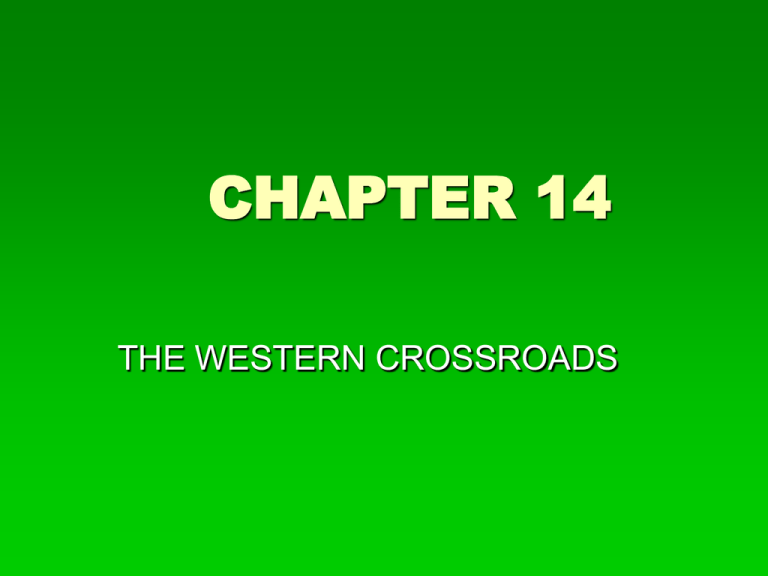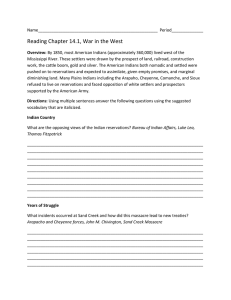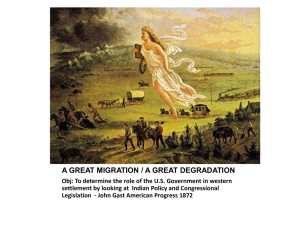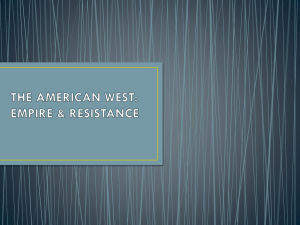chapter 14 - rasmussenj
advertisement

CHAPTER 14 THE WESTERN CROSSROADS What did Americans desire in the western lands? Farm land gold ASSIMILATION OF THE NATIVES AMERICANS to bring into conformity with the customs, attitudes, etc., of a group, nation, or the like; adapt or adjust: to assimilate the new immigrants. Government Assimilates the Natives Americans Placed on a reservation Controlled by the Bureau of Indian Affairs Forced to learn English Lost their native names INDIAN COUNTRY Bureau of Indian Affairs – Government agency responsible for managing the Indian issues INDIAN COUNTRY Government was dishonest to the Indians – failed to honor treaties INDIAN COUNTRY Government diverted supplies to the Indians INDIAN COUNTRY Indians angered because of starvation – turned to violence – attacking agencies, farms and towns Bureau of Indian Affairs Confrontation at Sand Creek John Chivington – Army Colonel – attacked Black Kettle’s camp in Colorado even though a white flag was raised 200 women and children were massacred (known as the Sand Creek Massacre) Indians stepped up their attack Colonel John Chivington Battle of Sand Creek Battle of Sand Creek Fort Laramie Treaty The Treaty of Fort Laramie (also called the Sioux Treaty of 1868) was an agreement between the United States and the Lakota nation, Yanktonai Sioux, Santee Sioux, and Arapaho signed in 1868 at Fort Laramie in the Wyoming Territoryguaranteeing to the Lakota ownership of the Black Hills, and further land and hunting rights in South Dakota, Wyoming, and Montana. BATTLE OF LITTLE BIG HORN Sitting Bull/Crazy Horse Last victory for the Sioux General George Armstrong Custer – 600 members of his Calvary were massacred Death to Custer and his Calvary Battle of the Little Big Horns - Montana SITTING BULL Crazy Horse Crazy Horse Monument General George Armstrong Custer THE GHOST DANCE Wovoka – (Indian Ghost Dance) Indians believed that the dance would bring back the buffalo heads Some wore ghost shirts – special symbols that could stop bullets THE GHOST DANCE Spread to the Standing Rock Indian Reservation in North Dakota. Sitting Bull was arrested – eventually killed with 14 other Indians Wovoka Ghost Dance BATTLE AT WOUNDED KNEE Wounded Knee, SD Sioux were angered by Sitting Bulls death and started their ghost dances Gov’t ordered the seizure of their rifles – searched their tepees – violence broke out- 150 Indians killed and 30 soldiers killed Battle at Wounded Knee, South Dakota in 1890 Death at Wounded Knee END OF RESISTANCE Chief Joseph – Nez Perce leader – attempted to escape to Canada – captured 40 miles from the border Geronimo – Apache leader that fled the reservation with 130 Indians and raided settlements – his surrender marked the end of the resistance in the southwest Chief Joseph – Chief of the Nez Perce Geronimo - Apache Chief ASSIMILATING THE AMERICAN INDIANS Dawes General Allotment Act – Indians received 160 acres of reservation land for farming Section 2 Western Farmers What were white Americas looking for? Cheaper land Make a new start Gold Why did African Americans leave the South ? Escape persecution in the South What were Scandinavians looking for? Had the “American fever” Fresh start Farm land North of Salem What about the Irish in this new land? Moved to the plains after building the railroads Many became farmers MONTROSE FIGHTIN’ IRISH Where did the Germans move from? Moved to the plains from the Mississippi Valley to the plains. Farmers Salem area What made the Chinese move to the west? Came during the gold rush Describe the difficulties that farm families faced on the Great Plains. Housing – poor (sod houses) Weather – blizzards in the winter and heat in the summer Insects – swarms of insects (grasshoppers) Fires – on the prairie were common Work – very hard and difficult LAND ACTS Homestead Act – white settlers could receive 160 acres of land – they needed to farm for 5 years 400,000 settlers took advantage of the act Homestead Act PACIFIC RAILWAY ACT Land given to the railroad companies linking the east to the west MORRILL ACT States received 17 million acres of federal land Constructed agriculture and engineering schools 70 state universities were founded SDSU Building of the Railroad OKLAHOMA HOMESTEADS 11 millions acres given to non-Indian settlers MOVING WEST Easterners – looking for a new life African-Americans – escape the persecution Exoduster – movement of the AfricaAmericans to the west SCARCE RESOURCES Lack of water – water sometimes 300 feet deep – used windmills to pump water Lack of trees Used dried buffalo manure Build sod houses SCARCE RESOURCES U.S. Department of Agriculture taught new methods of farming – dry farming BONANZA FARMING Large-scale farming – used more than 500 workers A 30-horse-drawn combined harvester and thresher in use near Moro, Oregon, ca. 1903. As machines grew larger, they required more horsepower to operate them. A further technological advance enabled a single machine to combine two or more steps of the harvesting process. With machinery like this, farms of thousands of acres known as "bonanza farms," employing hundreds of workers, transformed commercial farming into an agricultural industry. One such farmer produced 600,000 bushels of wheat in 1881. Farmers like him were just as much capitalists as J. P. Morgan and John D. Rockefeller, using other peoples' money to invest in land and machinery and mass-produce a needed product. In the 1870's pioneers faced a fierce attack of grasshoppers. The insects covered every inch of ground and ate all the vegetation within their path. On a Sunday in May 1876, Father Boucher appealed to a higher source for relief from the grasshoppers for his parishioners. The priest led his congregation on an all-day, eleven mile pilgrimage, placing three crosses in different locations. Though the grasshopper came again in later years, the area within the crosses was never touched. This cross is adjacent to St. Peter's Catholic Church in Jefferson, South Dakota. Another one of the crosses can be seen at the Morin farmstead 4 miles northwest of Jefferson on County Road 1B, and the third cross is on County Road 23 on the Dale Chicoine farm. Grasshopper Cross, Jefferson, SD Section 3 The Cattle Boom TEXAS LONGHORNS A breed of cattle from Texas (crossbreed of English and Spanish cattle) CATTLE TOWNS Were called railheads Towns along the railroad that shipped the cattle to market Kansas (Abilene, Dodge City, Wichita) RANCHING Open Range – cattle ranchers using public land or grazing land JOSEPH GLIDDEN Inventor of the barbed wire Ranchers refused to use because of injury to the cattle Wire was used to control land and water Conflict erupted between ranchers and farmers MINING IN THE BLACK HILLS Gold was discovered in 1876 In Lead City, Dakota Territory ARTICLES Western Frontier Copy of the Ft. Laramie Treaty Ft. Laramie Treaty (broken promises) Wild Bill Hickok U.S. Marshall in Abilene Kansas Came to Black Hills prospecting for gold Playing poker at the old Saloon #10 Killed by Jack McCall McCall wanted to have a reputation as a gun fighter “deadmans hand” – 2 aces, 2 eights, Jack Jack McCall Hanged in 1877 at age 24 In Yankton, Dakota Territorial capital Wild Bill Hickok Saloon #10 in Deadwood, SD Jack McCall Deadman’s Hand Test on Chapter 14 Test On Tuesday








